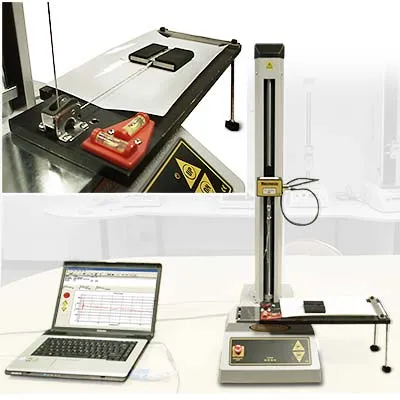Wine can pop-and-tear opening force


Solution
- Motorised tensile tester
- Container holder fixture adjustable to suit can diameter
- Chain-link and hook
Benefits
- Opening effort is clearly indicated as the peak point on the force-displacement graph
- Repeatable testing with quick set-up and fast throughput
Requirement
The traditional wine connoisseur has seen a packaging evolution in terms of closures; natural corks to synthetic cork materials to Roll-On Tamper-Evident/Pilfer-Proof (ROTE/ROPP) screw caps. The latter, adding a way to keep wine fresh and remove the temptation to drink a whole bottle in one sitting. Producers followed the wine drinker from the dinner party to the picnic. Packaging solutions have facilitated a move to wine ‘on the go’. The air-tight, light-proof, unbreakable aluminium drinks can has established itself as a viable container. The perception of being a healthier choice—by serving less volume than traditional bottles—as well as being lighter to carry, less potentially fragile, eliminating the corkscrew, and even a glass. In COVID times, these conveniences are still more valued through single-serving packaging and removal of the need to share opening devices or drinking receptacles.
Sealing the can now employs a ‘stay tab’ closure, the ‘pop tab’ design obsoleted due to swallowing hazard concerns. Opening the can requires the user to lift the ring, levering the tab down onto a pre-scored area of the end shell, which is pushed down into the can through the now-open aperture. The seal should “pop” open before the tab fails—usually at the attachment rivet where the maximum bend stress occurs.
The packaging manufacturer must optimise the lightweight design and eco-friendly recycling capabilities by ensuring enough physical strength in the can, the end shells and the tab. An interior, sprayed-lacquer coating must protect the metal from the acidic qualities of the wine, have no influence on taste or any detrimental effect on the ease of opening.
Solution
The indicator of openability for a stay-on-tab design is the peak effort required to breach the scored end-shell tab on the lid surface. Mecmesin’s easy-to-use motorised force test stands enable this tensile force to be displayed as a peak value on a digital force gauge or to be determined from the more detailed graphical output on software-controlled test systems.
To simulate the action of a consumer pulling up the tab ring with the end of their finger, a small hook is carefully located around the ring, only slightly flexing the metal elastically. The chain link allows the hook to slip around the ring as it is pulled cleanly upwards, without artificially stressing the component.
The lower fixture holds the round can body securely, eliminating vertical slippage or crushing. The four adjustable foam pegs grip the can for the short duration of the pull as the test stand’s crosshead moves upwards at a constant rate, thereby ensuring repeatable, consistent testing. For other geometries or particularly low-friction finishes, Mecmesin can design fixtures which hold the container by virtue of pneumatic clamps or restraining bars across the top face of the container. For tests requiring a pull-peel action over a significant distance, an assisted-pull peel table can be used to ensure a constant angle of pull.
This ‘pop-and-tear’ test can be used at the packaging manufacturer’s end-of-line quality assurance point or as an outgoing check by the wine producer after production at the canning line.
Test equipment
- Motorised tensile tester
- Can holder
- Chain link assembly and hook












